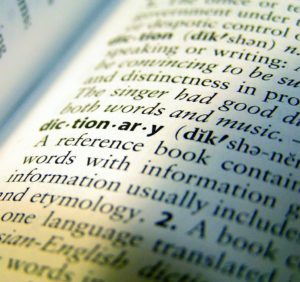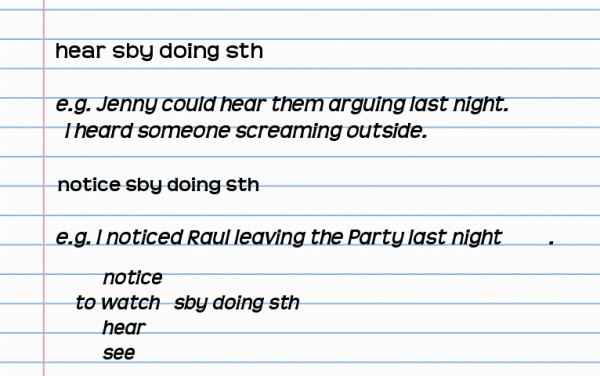Vocabulary Notebooks – Part 2

In the last blog we discussed some ways of recording collocations in your vocabulary notebook and asked you to share some of your ideas. We made the point that words like the company of other words; that words like to hang out together. We looked at how words combine. This week we’ll be focusing on patterns.
This week:
Rule No 2: Words have patterns
As we have seen, collocation refers to the way words combine (heavy traffic, miss a plane, take a rest). However, we also need to pay attention to the grammatical patterns of words.
For example, verbs of perception, such as hear, notice, and see often have the pattern:
“to hear/notice/see somebody (sby) doing (sth)”
I heard my neighbour making dinner last night.
When you look up the word “hear” in a good online Dictionary (I’m using Longman Dictionaries Online. http://www.ldoceonline.com/) you will often see examples of HOW that word is used:
Jenny could hear them arguing last night.
Did you notice him leaving the Party last night?
I heard someone screaming outside.


Using an Online Dictionary to find patterns
To make the most of a dictionary, there are two basic things you should do when you look up a word:
- Write down the basic pattern the word takes, e.g. for “hear: to hear sby doing sth”).
- Then you need to write FULL examples in your vocabulary notebook. It’s best to write a personal example as well, so you can remember it better, e.g. “I heard Miguel laughing at The Simpsons on TV.”
So try not to just copy the examples from the dictionary. Follow the pattern carefully, but make your own sentences, about your life, your thoughts and feelings.
Remember: examples are as important as definitions: because I am writing the FULL sentence, I am learning the prepositions and objects that are used with these words. For example: laughing at the Simpsons on TV.
Here’s a sample page from a student’s vocabulary notebook:

As we can see above:
– the meaning or use of a word (e.g. hear) can often determine the pattern it will follow:
“hear sby doing sth”
– other verbs with similar or related meanings and uses often follow the same pattern:
“notice/hear/watch/see sby doing sth”
In conclusion, learning a word means you should learn the pattern it takes. Then, you should learn how to use that pattern. This will really improve your written and spoken English, and it will help you with reading and listening too. You’ll be paying attention to patterns, (and, of course, collocations) rather than lonely little words that can’t do much on their own.
I know this sounds crazy, but words have grammar!
So get going and let us know if you see or hear anybody doing anything interesting.
A big thanks to Hugh Dellar and Andrew Walkley for allowing us to use some of their ideas in this blog series.
